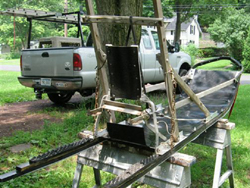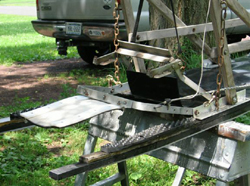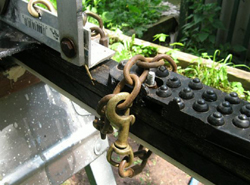In This Issue....
Sledge Dog Memorial Fund Update
Product Review: Collasate™/EMT™
Navigating
This Site
Index of articles by subject
Index
of back issues by volume number
Search The
Fan Hitch
Articles
to download and print
Ordering
Ken MacRury's Thesis
Our
comprehensive list of resources
Talk
to The
Fan Hitch
The Fan
Hitch home page
ISDI
home page
Editor's/Publisher's Statement
Editor: Sue Hamilton
Webmaster: Mark Hamilton
The Fan Hitch welcomes your letters, stories, comments and suggestions. The editorial staff reserves the right to edit submissions used for publication.
Contents of The Fan Hitch are protected by international copyright laws. No photo, drawing or text may be reproduced in any form without written consent. Webmasters please note: written consent is necessary before linking this site to yours! Please forward requests to Sue Hamilton, 55 Town Line Rd., Harwinton, Connecticut 06791, USA or mail@thefanhitch.org.
This site is dedicated to the Inuit Dog as well as related Inuit culture and traditions. It is also home to The Fan Hitch, Journal of the Inuit Sled Dog.

The drag mat is up and out of the way.
Merely pushing it down
by hand will put it at the
ready. Note the brake chains in their
stored position along the upright
stanchions of the driver's bow.
photo:
Weiss
Drag Mats and Other "Drag-Ons"
by Chuck Weiss Perkasie, Pennsylvania, U.S.A.
Not being a sled dog racer, I sometimes find that I can fall behind on the latest in technical advances in the world of dog sledding. I build my own sleds, and usually I just stick to the same basic design as it has proven tough, reliable and serviceable for many years. With our busy freighting schedule and the horrible snow conditions here in the east, even the best of sleds will succumb to heavy loads and the occasional confrontation with a tree. I find myself building or at least rebuilding one of our sleds every year. But a few years back I got the crazy idea that I should look into reworking my sled design. You know…see what's out there that I could add to my sled to make it go easier, stop quicker and add a little bit of…dare I say it…control!
So I looked at other people's sleds, 'googled' sled makers, and spoke to racer friends to see what worked and what didn't for them. After doing all this highly technical research, I was faced with translating this information into "freighting" terms. After all, the latest lightweight carbon fiber sled with only a nylon bag as a basket would not hold up to the 400-600 lb (181-272 kg) loads we routinely put in our sled. There were many advances which seemed tempting, but the one that caught my eye as a simple (read: inexpensive) add-on with a lot of impact was the new drag mats I found many sled makers adding to their product line.

The drag mat is in the down
position. The white cord on the
right side is used to pull it up and out
of the way. The bungee
cord (horzontal to the right
runner) keeps the drag mat up and
out of the way. Note how one
end of the chain brakes are
attached to the
runners.
photo:
Weiss
Many of you may be familiar with drag mats. I used to have one on my sled. It was a section of snowmobile tread cut to fit between the runners and tied to the back stanchions. The idea was to step on the mat instead of the brake when I wanted to just take a little speed off the team. Great idea! But as with other great ideas, there were complications, like when you have an old hunk of tread between your runners and go to step on the main brake to really stop the team before they go tearing across a lake toward some unsuspecting ice fisherman…and the brake is caught on your drag mat because it slipped out of position…and you find yourself gaining speed instead of slowing down…and you reach down to straighten the drag mat out and just about then your team is in a ball around a nice older gentleman who is trying to be polite as your Inuit Sled Dogs shred his entire catch for the day and turn his tranquil day of ice fishing into a chaotic, bloody stain of leftover fish on the ice! Not that this ever happened to me. It's all theoretical of course (wink)!
The good news is that I found a solution which allows me to use my double claw brake when I need it plus the convenience of a drag mat. I purchased this wonderful device from Arctic Star Sleds in Tyrone, Pennsylvania, U.S.A. It was developed and made by Johnn Molburg, who is well known in mushing circles in the U.S. and Canada. Johnn's drag mat is mounted on an aluminum frame and has plastic stiffeners to keep it in place, which allows for the easy use of a double claw brake even with the drag mat in the down position. The mat comes with a bungee cord that permits it to be quickly retracted when not needed. Made for use with Johnn's sleds, I easily modified it to work on my home made sleds. I also added a few hex head screws to the business side of the mat to give it a little more bite on ice.
Like all new things it took a few runs to adjust to this new drag mat, but I can easily say it is worth getting used to. The drag mat stays where you put it, works well if you want to take off a little too much speed, is helpful when snow is shallow and claw brakes can get caught on tree roots. The best part is that with just the touch of a cord it pops up out of the way!

The chain brake in working
position.
photo:
Weiss
I've also found a new way to attach an old tool. From time to time I have used chain brakes on my runners to help slow a large load heading down a steep hill. The problem is that when you need chain brakes they are usually buried deep in your sled bag. Your team is banging their harnesses eager to get going and you end up not putting the chains on. A while back I learned a trick from an old time freight musher. He attaches one end of a chain to the runners and keeps the other end clipped to the sled bag, up and out of the way. When the chains are needed, he just unclips them from the bag and wraps them around the runners. Its easy simple and I love it!
My next step is to build one of those sit down sleds, complete with cup holders, GPS, and satellite radio!